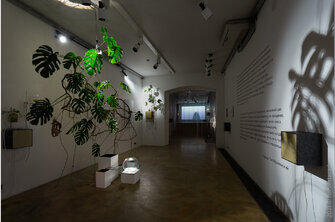Ivan Karpov and Daniil Koronkevich
SPRING 21
Project is supported by:
- Frants Art Foundation
- Time Technology
- Artitec
Text: German Preobrazhensky
This exhibition presents spring as a self-replicating topic, which is brought by the power of art into the exhibition space of the gallery. The artist himself conceives the construction of this exhibition as a “recipe of spring” woven from sounds, plants, scents and light. The “elementums” from which this eternally awakening canvas is woven are gathered at the exhibition into a single installation sequence. Essentially, an entire laboratory is formed at the exhibition, a series of experiences, and at their measured pace an enchanting renewal of the world is born by the will of the creator. As we move from hall to hall, we get closer to the artist’s concept, to give a perceptual map of the spring mood – varia mens – endless variations on the motion of an abundance of natural power. The work of art manifests itself in a certain violation of this synthesis: by dispersing spring into “elementums” like an alchemist, the artist then gathers its fantastic living organism into a whole. The nature of this gathering is firmly connected with the time of the exhibition – the bright sun and awakening nature, and is also connected with the space – the integral floristic assemblies, literally sculptured in the whiteness of the gallery, also transform the place.
The author observes the customary aspects of plant life – vegetative growth, symbioses, rhizomatic proliferation, and presents this tender life as analytical procedures of viewing and projection into natural processes. Projection primarily from the non-human side.
Does nature need our gaze to bask in the rays of its own calm and disorder? Do we get closer to the essence of art when we overcome the mimetic boundary established by our own conditional presence around customary exhibition forms?
And perhaps the most important question of the exhibition – is the world centered in our gaze, do we make this whole perfect only because we see it that way; could it be that the world is merely a disordered accumulation of impressions, growth, events until art comes to it?
The rather banal idea of beauty as proportion and congruity is imparted from an unexpected angle at this exhibition.
It is widely believed that entropy is disorder, but that beauty is connected with regulation. But the very phenomenon of growing, of vegetation and new things, are a manifestation of entropy. In the place where there was a pure gallery space, by the efforts of the artist a work of art emerges, which we undoubtedly see as a positive accretion. But in relation to the initial field of purity, the work will be an act of entropy. Beauty is connected with the multiplication of life, and the multiplication of differences. Differences grow like plants in the vessels of art, we do not control these differences or their growth. From the objective standpoint, this is indeed the multiplication of disorder. But when an exhibition provides us with access to art, we see the world differently. We record how these differences grow through us, gaining order, winding into ever new iterations of creation. This constant proliferation of life has an immanent nature, it goes deeply into the very concept of beauty as proportionality, overturning and recalibrating its mutual connection with the world of non-human relations.
A botanic attraction charms us and draws our attention. The artist, as a consistent didact, teaches us the contemplation of becoming: when the light shifts, like in the world of Plato’s cave, figures of understanding are born – schematics. The beakers throw shades on the wall, or suddenly withdraw into transparency. The symbolic configurations of the laboratory vessels form an allegory of the human body – cavities and streams, connections and dissolution of one into another. The culmination of the exhibition is a barely noticeable event that has profound symbolic importance for the author. The phenomenon of water dispersion, presented as an exquisite gastronomic dish through a system of retorts and flasks, is captured as the fluid algebra of radiance. The disintegration of the spectrum forms a luminous rainbow, as if hinting at the co-natural character of art as tidings from God. “And the bow shall be in the cloud; and I will look upon it, that I may remember the everlasting covenant between God [and between the earth] and every living creature of all flesh that is upon the earth.” – Genesis 9:16.
This connection crowns the completeness of creation, it is restored every time with the coming of spring, bringing hope of forgiveness. Thus, through the complex taxonomy of rules and combinations, through a search of harmony in a complex, constantly expanding Universe, the author seeks forgiveness as a renewal (apocatastasis) of the once-lost unity with the world. He also gives us the ability to see the light, to become equal with the logic of creation.


















